Youth sports have become more competitive, leading to overuse injuries. Riverside Sports Therapy aims to protect young athletes from long-term damage. This damage comes from repetitive strain and intense training.
Pediatric sports injuries are serious and can affect an athlete’s future. Our approach is to understand athletic stress and use prevention strategies. This helps young athletes stay healthy and perform well.
Managing injuries in youth sports requires a proactive approach. We educate parents, coaches, and athletes about the dangers of overtraining. This way, we can make sports safer for everyone, focusing on both performance and health.
Key Takeaways
- Early recognition of overuse injuries is key for long-term health
- Specialized training needs careful monitoring and balanced methods
- Prevention is better than treating injuries after they happen
- Proper technique and rest are essential to prevent injuries
- Understanding the risks helps minimize athletic dangers
Understanding Overuse Injuries in Youth Sports
Youth sports are filled with physical challenges that can harm young athletes’ health and performance. Repetitive strain injuries are a big worry for parents, coaches, and doctors working with young athletes.
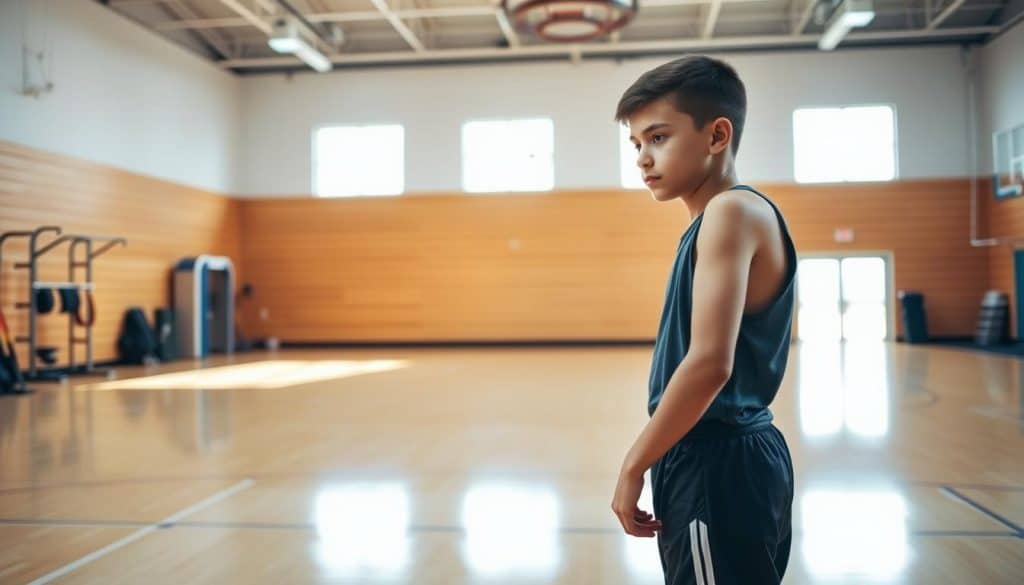
Repetitive strain injuries happen when constant stress is put on certain body parts during sports. These injuries grow slowly, often without sudden pain. This makes them very dangerous for young athletes.
Common Types of Repetitive Strain Injuries
- Tendonitis in shoulders and elbows
- Stress fractures in growth plates
- Knee and ankle ligament strains
- Chronic muscle inflammation
Risk Factors and Warning Signs
Young athletes face special risks because of their growing bodies. Key risk factors include:
- Intense training without enough rest
- Starting sports too early
- Using wrong techniques and training methods
- Going through rapid growth during puberty
“Prevention is always better than cure in youth sports injury management.” – Dr. Sarah Thompson, Sports Medicine Specialist
Impact on Athletic Development
Untreated repetitive strain injuries can stop a young athlete’s growth. It’s important to catch and treat these injuries early. This helps avoid long-term problems and chronic conditions.
The Rising Epidemic of Youth Sports Injuries
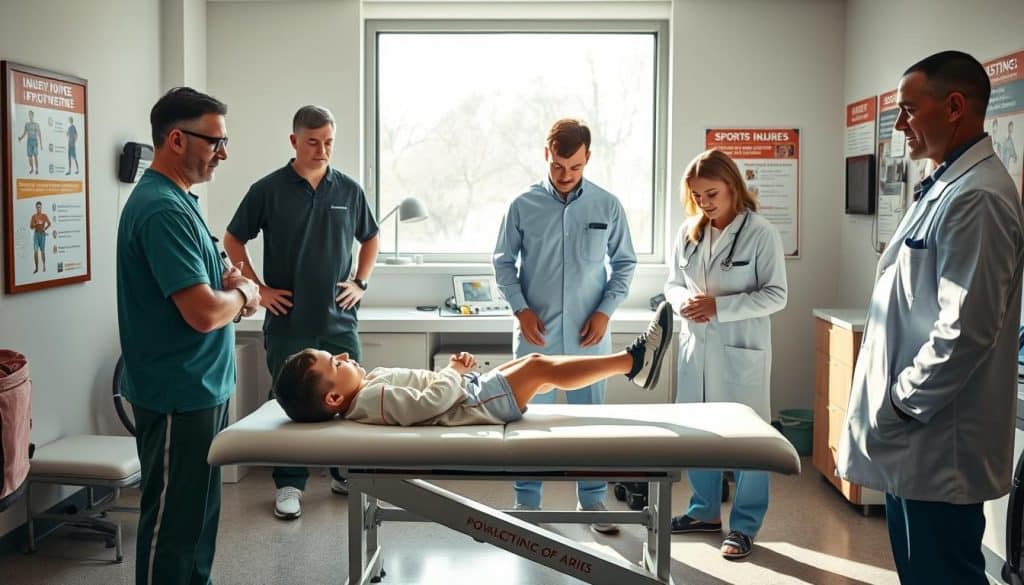
The world of youth sports injuries has changed a lot in recent years. Young athletes now face more challenges than ever in their sports careers.
Recent studies show a worrying trend in youth sports injuries. Experts point to several key factors:
- Early sports specialization
- Intense year-round training regimens
- Increased competitive pressure
- Limited recovery time
Numbers show the serious situation we’re in. According to the Centers for Disease Control and Prevention, about 2.6 million kids under 19 get hurt in sports every year. This shows we need better ways to prevent injuries.
“The current approach to youth sports is unsustainable and potentially harmful to young athletes’ long-term health,” says Dr. James Andrews, a leading sports medicine physician.
Kids aged 10-14 are most at risk. Their bodies are growing, and they’re expected to perform more in sports. High-intensity sports like soccer, basketball, and gymnastics are the riskiest.
| Sport | Injury Rate | Most Common Injuries |
|---|---|---|
| Soccer | 12.5 per 100 participants | Knee and ankle sprains |
| Basketball | 10.2 per 100 participants | Ankle injuries, finger fractures |
| Gymnastics | 15.8 per 100 participants | Wrist and shoulder injuries |
Dealing with these injuries needs a broad approach. We must look at physical, mental, and growth factors. Parents, coaches, and doctors must work together to make sports safer for kids.
Early Warning Signs Parents Should Watch For
Keeping an eye on youth athlete health is key to avoiding injuries in sports. Parents are vital in spotting early signs of health risks in young athletes.
Knowing the early signs of injury can greatly help a young athlete’s future in sports and overall health.
Physical Symptoms and Red Flags
Young athletes may show physical signs that suggest they might be getting injured:
- Persistent pain during or after sports
- Less ability to perform well
- Changes in how they move
- Swelling or inflammation in joints
- Recurring muscle or joint stiffness
Behavioral Changes in Young Athletes
Mental and emotional changes can also hint at health issues:
- Not wanting to play sports they used to love
- Being more irritable or having mood swings
- Less excitement during training
- Feeling very tired or exhausted
When to Seek Professional Help
“Early intervention is key to preventing long-term athletic injuries.” – Sports Medicine Expert
Parents should get a doctor’s opinion if their young athlete has:
- Pain that lasts more than a week
- Big changes in how well they perform in sports
- Visible physical limitations
- Constant mental distress related to sports
Watching closely and getting help early can protect young athletes from serious health problems later on.
Sport-Specific Injury Patterns and Prevention
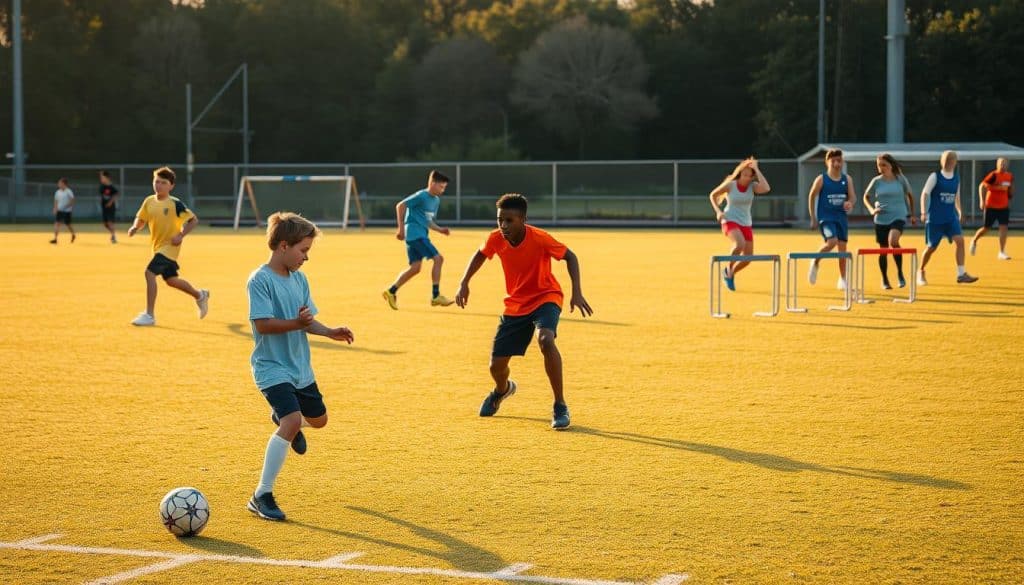
Young athletes face unique challenges in different sports. Injury prevention strategies are key for their long-term success. Each sport has its own repetitive strain injuries that need specific protection during growth.
Every sport requires its own injury prevention methods. Volleyball players often get shoulder and knee injuries. Swimmers face shoulder and lower back problems. Knowing these risks helps coaches and parents take action to protect young athletes.
- Baseball: Focus on protecting throwing arms and shoulders
- Soccer: Knee and ankle injury prevention techniques
- Gymnastics: Wrist and spine stress management
- Basketball: Ankle and knee joint protection strategies
Creating effective injury prevention plans is complex. Proper technique, the right equipment, and age-appropriate training are vital. They help lower the risk of injuries in young athletes.
Important prevention tips include:
- Regular biomechanical assessments
- Sport-specific strength conditioning
- Implementing adequate rest periods
- Using properly fitted protective gear
Experts suggest personalized training plans. These plans consider each athlete’s physical abilities and injury risks. Tailoring prevention strategies to specific sports and athletes can greatly reduce injury chances.
The Role of Proper Training Techniques
Young athletes face big challenges in finding safe and effective training. Teaching the right techniques is key to avoiding injuries and improving performance. It’s important to tailor training to each athlete’s unique needs.
Good training is more than just doing exercises over and over. It needs a deep understanding of each athlete’s strengths and weaknesses.
Fundamentals of Safe Training
- Develop consistent movement patterns
- Focus on technique before intensity
- Implement gradual progression strategies
- Emphasize body awareness and control
Age-Appropriate Exercise Programs
| Age Group | Training Focus | Key Considerations |
|---|---|---|
| 8-10 years | Basic movement skills | Fundamental motor skill development |
| 11-13 years | Technique refinement | Introducing sport-specific movements |
| 14-16 years | Strength and conditioning | Progressive resistance training |
Recovery and Rest Protocols
Rest is not a sign of weakness but a critical part of getting better. Proper technique coaching includes rest times to avoid injuries and help athletes grow.
“Training smarter, not just harder, is the key to sustainable athletic performance.” – Sports Medicine Expert
By following these safe training practices, young athletes can reach their goals without getting hurt. This way, they can unlock their full athletic ability.
Impact of Sports Specialization on Young Athletes
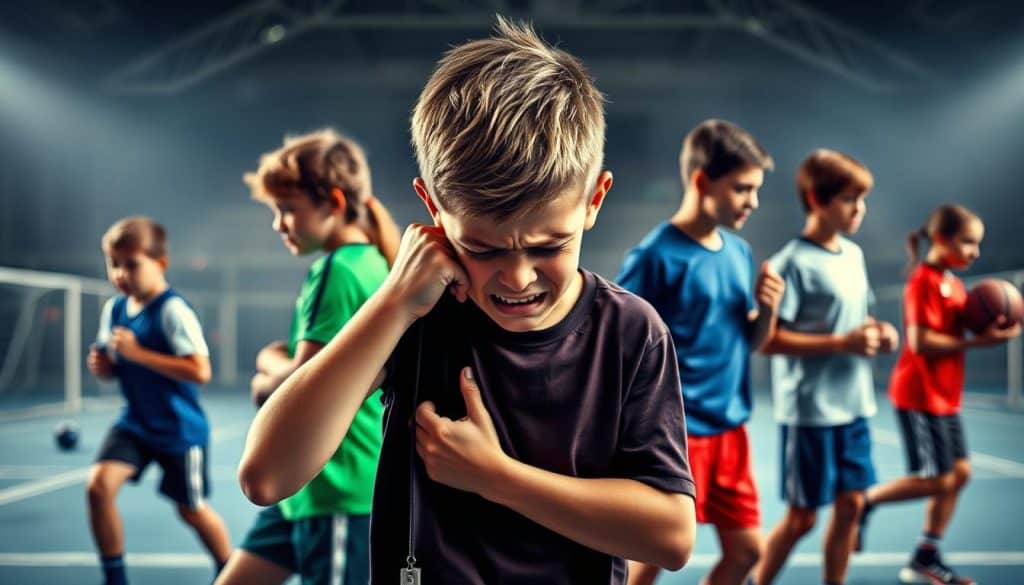
Sports specialization is growing among young athletes. It might seem good, but it’s a big worry for their health. Many think early focus will make them stars, but studies show it’s not that simple.
Early sports focus can be risky. Young athletes who only play one sport face big challenges:
- Increased risk of overuse injuries
- Higher psychological burnout rates
- Limited overall athletic development
- Potential long-term physical strain
“Diversification, not specialization, builds truly resilient athletes.” – Dr. Andrew Luke, Sports Medicine Researcher
The American Academy of Pediatrics suggests a balanced way. Multilateral athletic development lets kids try different sports. This lowers injury risks and keeps them interested. It helps them learn many skills and avoid chronic injuries.
Young athletes do best with training that matches their age. It should focus on basic skills, fun, and learning slowly. Parents and coaches should create supportive spaces for kids to explore sports, not rush into one too early.
Building a Foundation for Injury Prevention
Creating a strong injury prevention plan is key for young athletes. It helps them stay healthy and perform well in sports. Safe training starts with knowing how growing bodies need different exercises.
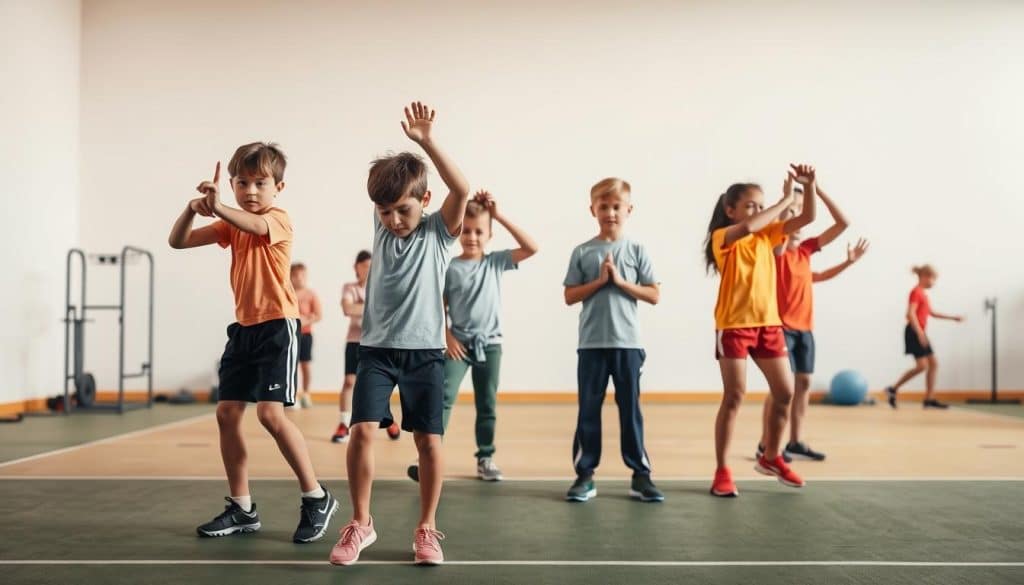
Young athletes need training that boosts their physical growth and keeps them safe. Injury prevention is more than just doing exercises. It’s about a complete approach to getting ready for sports.
Strength Training Guidelines for Young Athletes
Good strength training for young athletes means using the right methods:
- Start with bodyweight exercises to learn the right form
- Use gradual resistance training with light weights
- Focus on how you do the exercise, not how heavy it is
- Train 2-3 times a week
- Change which muscles you work to avoid overuse
Flexibility and Mobility Work Essentials
Being flexible is key to safe training. Young athletes should do dynamic stretches and mobility exercises that:
- Help them move better
- Improve how their muscles work together
- Lower the chance of getting hurt
- Boost their sports performance
By using these injury prevention strategies, coaches and parents can help young athletes build a solid base for their sports careers.
Recovery Strategies for Youth Athletes
Recovery is key for young athletes to avoid injuries. They work hard, so rest is vital for their growth and success.
Good recovery plans cover both body and mind. Athletes need a mix of physical and mental care to heal and get better.
- Active Recovery Techniques
- Light stretching
- Low-intensity movement
- Foam rolling
- Nutritional Support
- Balanced protein intake
- Hydration optimization
- Nutrient-rich meals
Sleep is essential for athletes to recover. Teens need 8-10 hours to fix muscles, balance hormones, and calm their minds. A regular sleep schedule keeps them at their best and safe from injuries.
“Recovery is not about doing nothing, but about strategic regeneration.” – Sports Medicine Expert
Mental recovery is just as vital. Using mindfulness, managing stress, and getting mental health help can stop burnout. It keeps young athletes healthy in body and mind.
Experts say each athlete needs a recovery plan made just for them. It should look at their sport, age, and health. Watching how hard they train and adding breaks helps avoid injuries.
The Importance of Cross-Training
Cross-training is key for young athletes to become well-rounded. It helps them build physical skills and lowers the risks of focusing too much on one sport. This way, young athletes can enjoy a variety of sports, making their training more balanced.
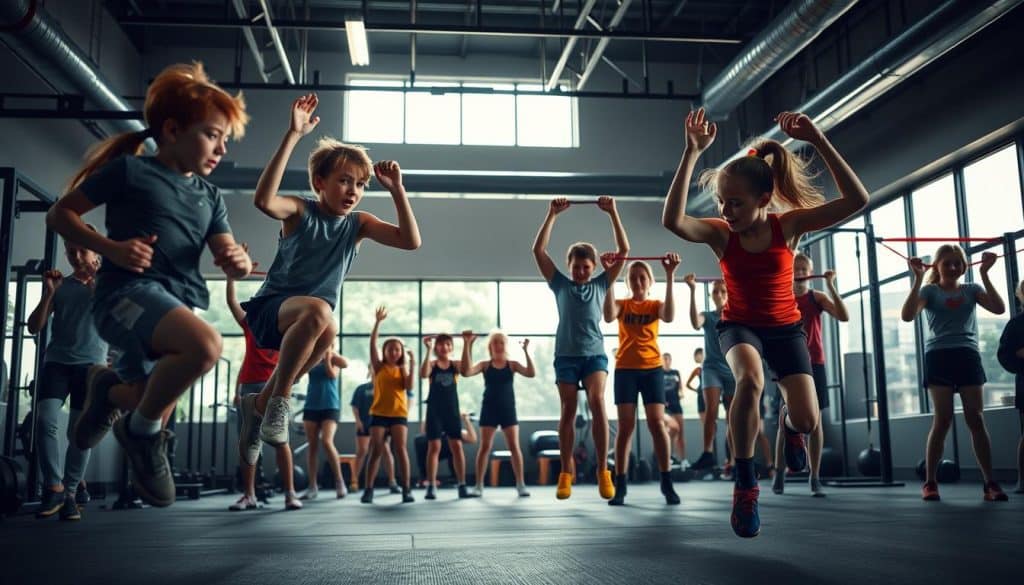
Developing young athletes in sports needs a smart plan that looks beyond one sport. Cross-training brings many benefits for young athletes wanting to improve their athletic skills.
Benefits of Multi-Sport Participation
- Develops diverse muscle groups through varied physical activities
- Reduces injury risk by preventing repetitive strain
- Enhances overall athletic coordination
- Prevents mental burnout from single-sport specialization
Seasonal Training Approaches
Strategic seasonal training helps young athletes stay fit and avoid injuries. Switching between sports allows for rest and learning new skills.
| Season | Primary Sport | Secondary Activities |
|---|---|---|
| Summer | Swimming | Cycling, Running |
| Winter | Indoor Hockey | Strength Training, Yoga |
| Spring | Track | Soccer, Basketball |
By following cross-training, young athletes can grow their athletic abilities. They also keep their health and performance strong for the long term.
Parent and Coach Education Essentials
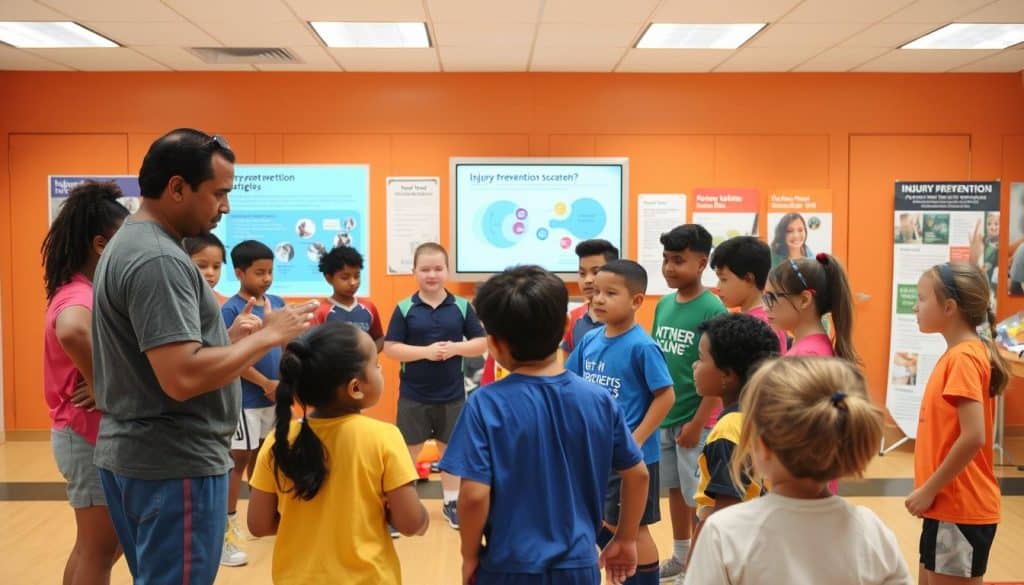
Teaching proper techniques is key to keeping young athletes safe. Parents and coaches are the first line of defense. They prevent overuse injuries by learning important educational principles.
To prevent injuries, adults need to know a lot. They must:
- Spot early signs of physical and mental tiredness
- Know what training is right for each age
- Use smart rest and recovery plans
- Watch how each athlete is doing physically and emotionally
Coaches should focus on long-term athletic growth more than winning. This approach lowers stress and injury risks for young athletes.
| Education Focus Area | Key Strategies |
|---|---|
| Physical Training | Gradual skill progression, balanced workout routines |
| Mental Wellness | Stress management, positive reinforcement |
| Injury Prevention | Regular health screenings, proper technique instruction |
By using educational resources and talking openly, parents and coaches can make a safer space. They help young athletes grow while keeping them safe from sports risks.
Creating Safe Training Environments
Creating a safe place for young athletes to train is key to avoiding injuries. It’s not just about watching them; it’s about having a plan to keep them safe. This plan should cover all the possible dangers they might face.
Critical Equipment and Facility Safety Considerations
Having the right gear and keeping facilities in good shape is vital. Youth sports groups need to check safety regularly. They should also have strict rules for keeping things in order.
- Inspect sports equipment for wear and damage
- Ensure proper padding and protective surfaces
- Maintain appropriate safety gear specifications
- Create clear emergency response plans
Navigating Weather and Environmental Challenges
Weather and the environment can be big risks for athletes. Coaches and trainers need to be ready to adapt to these changes.
- Monitor temperature and humidity levels
- Implement hydration protocols
- Adjust training intensity during extreme weather
- Provide appropriate protective clothing
Knowing and dealing with environmental dangers can greatly lower the chance of injuries for young athletes.
Safety isn’t an accident—it’s a deliberate and continuous commitment to athlete well-being.
Long-term Athletic Development Guidelines
Building young athletes needs a careful plan that focuses on their health and growth. It’s important to use training loads that fit their age. This helps grow their athletic skills without risking injuries or burnout.
Understanding what young athletes need at each stage is key. Coaches and parents must tailor training to fit each age group’s needs.
- Set milestones for skill growth
- Use training plans that match their age
- Focus on how well they move, not just how much
- Work on the whole athlete, not just their skills
“Athletic excellence is a journey, not a sprint. Patience and systematic approach are fundamental to nurturing young talent.” – Sports Development Expert
Important parts of long-term athletic development include:
- Individualized training programs
- Balance physical and mental training
- Check how they’re doing regularly
- Change training methods as needed
Using detailed training plans that match their age helps young athletes build strong athletic bases. This method lowers injury risks and boosts their chances of lasting success in sports.
Treatment Options at Riverside Sports Therapy
Young athletes with sports injuries need special care. Riverside Sports Therapy offers detailed solutions for repetitive strain injuries. We focus on rehabilitation and keeping athletes healthy for the long term.
We understand each athlete’s unique challenges. We create recovery plans that fit their needs.
Specialized Youth Programs
We have special programs for young athletes with overuse injuries:
- Comprehensive injury assessment
- Individualized rehabilitation plans
- Strength and conditioning protocols
- Biomechanical movement analysis
Professional Assessment Process
Our assessment for pediatric sports injuries includes:
- Detailed medical history review
- Comprehensive physical examination
- Advanced diagnostic screening
- Personalized treatment recommendation
Athletes heal faster with targeted, expert-driven care.
We know how complex repetitive strain injuries are in young athletes. Our team works together to help them recover quickly and prevent future problems.
Want to help your young athlete? Call Riverside Sports Therapy at (403) 283-7551 for expert advice.
Role of Medical Professionals in Prevention
Medical experts are key in keeping young athletes safe. They go beyond just treating injuries. They focus on preventing them before they happen.
Effective medical help in sports includes several important steps:
- Comprehensive pre-participation screenings
- Individualized risk assessment
- Biomechanical evaluation
- Personalized injury prevention recommendations
Sports medicine doctors and trainers work with coaches and parents. They create plans to avoid injuries. Early detection and intervention are key to keeping young athletes healthy.
“Prevention is always better than cure, specially for young athletes’ growing bodies.” – Dr. Sarah Roberts, Sports Medicine Specialist
The medical approach to preventing injuries includes:
- Regular physical exams
- Strength and conditioning checks
- Nutritional advice
- Guidance on recovery and rest
With thorough medical care, young athletes can lower their injury risk. They can stay at their best and keep their bodies healthy for the long term.
Conclusion
Preventing overuse injuries in youth sports needs a team effort. Parents, coaches, and young athletes must work together. Riverside Sports Therapy focuses on keeping young athletes safe and healthy.
Teaching about early warning signs is key. Proper training and a balanced sports schedule help a lot. This way, we can protect young athletes from long-term harm.
Our studies show that being proactive is important. Cross-training, rest, and expert advice are vital. Young athletes should be able to grow their skills safely.
If you need help with overuse injuries in youth sports, call Riverside Sports Therapy at (403) 283-7551. We offer programs to help young athletes reach their goals safely.
